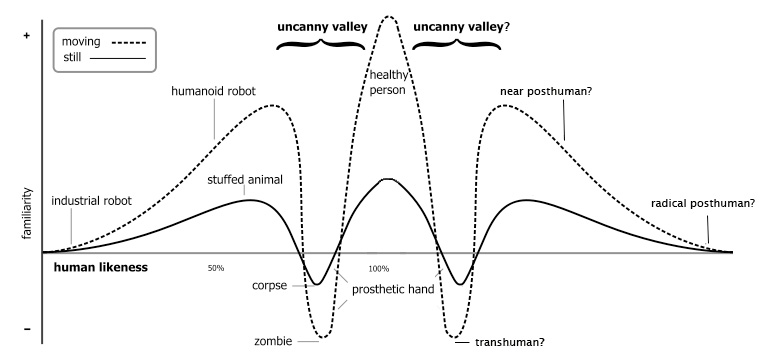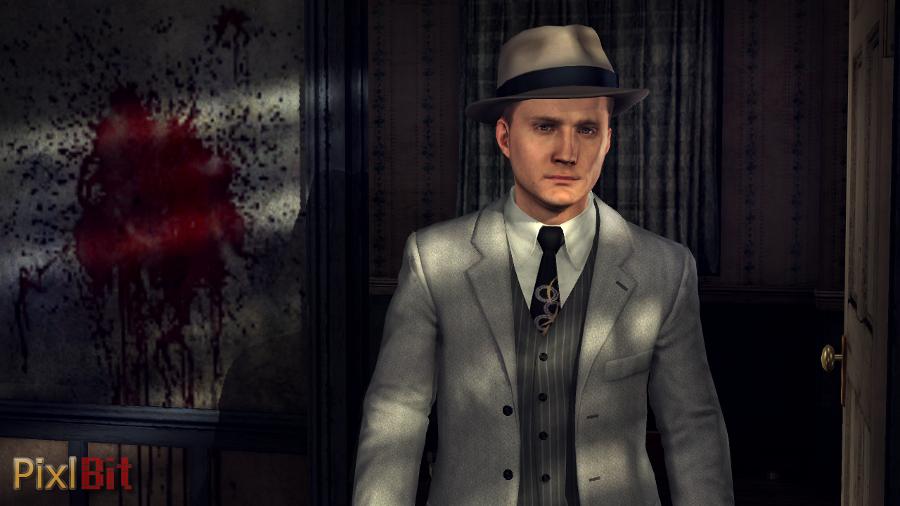Traversing the uncanny valley

It was in the late 1970s that Masahiro Mori first observed what was later termed the uncanny valley. Through his work in robotics he noted that the human emotional response to his machinations would become more positive as they became more human in appearance and mannerism. This general upward trend in positive emotional response would continue until the robot achieved a level of near human realism, at which point the human reaction would drop off to the point of revulsion. The human reaction would remain in this uncanny valley and would only rise again once there was no discernable difference between the robot and a living, breathing human being.
This concept of the uncanny valley helps to explain why we have generally positive reactions to vaguely humanoid machinations such as puppets, but find much more fault and have less empathy for more realistic humanoid robots. There is something uncanny and ultimately unsettling about these ‘near perfect’ representations of human beings and it affects how we receive them on an emotional level.

While this hypothetical uncanny valley was conceived within the field of robotics, the concept has since been modified to apply to all forms of artificial representations of human beings – including simple illustrations, animation and, of course, video games.
Video game developers have been trying to break through the uncanny valley since the industry first began. As game graphics and sheer processing power have evolved at an exponential rate, so too has the realism of our digital human characters. You could draw the rising line from Pac-Man and Pitfall Harry up to Mario, Sonic and Crash Bandicoot. But with the last and current generation of games, this line has started a downward trend with characters in games like Mass Effect, L.A. Noire and Deus Ex: Human Revolution. Admittedly these games are graphical powerhouses and look fantastic, but there is something inherently strange about the human characters during interactive moments in the game.
Part of what makes the uncanny valley even more difficult for developers to surpass is the correlation between the audience’s negative emotional reaction and the movement of the character models. What this means is that an individual may not find fault or be put off by a static screen shot of a character, but when that model is put into motion, the individual will be drawn to the perceived strangeness of the character’s mannerisms and actions. So while Cole Phelps from L.A. Noire looks fantastic in screen captures, it isn’t until you see the character in motion that you would notice the woodenness and inhumanity of his gestures and general movements. If we were to show you a more stylized character like Viewtiful Joe, you wouldn’t find any of his movements unnatural. It’s because Cole is so human looking that we find fault and become uneasy.

In terms of technology the question isn’t normally if we will accomplish something, but when we will we accomplish it. This may not be the case with the uncanny valley. It is said that the other side of the human valley is the unaltered human being. The important word in that last sentence is unaltered. It is thought that even human beings can fall into the uncanny valley if there are aspects of their makeup that are artificial. This includes piercings, prosthetic limbs and artificial augmentations.
Deus Ex: Human Revolution actually touches on the uncanny valley in both its classical definition and in terms of transhumanism. The classic uncanny valley is well represented in this game, with NPCs programmed with very limited range of emotional conveyance and physical locomotion. Ask an NPC a question and they may not even look at you as they issue forth a scripted response. And if they do happen to make eye contact it becomes difficult not to notice how soulless the character appears. While more attention is taken in the animation and voice acting of the main cast of characters, these fundamental short comings are still present to a degree. This is by no means the fault of the programmers, rather a fundamental issue concerning the human condition that at present we are unable to convey through artificial means.
More interestingly though is how Deus Ex: HR discusses transhumanism and humanity’s growing desire to become something more than human by seemingly deciding to become less human through the use of artificial augmentations. Without giving any details concerning the plot away, Deus Ex: HR presents a world with a fractured viewpoint on the topic of augmentation. A substantial portion of the population is against the very idea of voluntarily replacing portions our bodies with biomechanical components as a means of making ourselves better. The rationales behind this rejection are many and varied, but they all are born in the uncanny valley – augmented individuals are seen as being less than human which is an unsettling concept.
Through the eyes of our protagonist, Adam Jensen, the user is able to behold the effects of the uncanny valley from the perspective of the machine. There is a very real difference in how Jensen is emotionally received by NPCs post augmentation – there is a palpable unease involving interactions with ‘normal’ characters. This gives us a glimpse as to how the uncanny valley may have an effect on how society will deal with the possible future in which the lines between human and machine begin to blur.

While it’s likely that the uncanny valley will never be broken through, there are developers that are creating fantastic games by using the concept of the uncanny valley to their advantage. Remember, there is a high point before we descend into the valley. This high point can be utilized by creating highly stylized humanoid characters that are able to draw on a higher level of positive emotional response by not trying to be perfect representations of human beings. A game like Gears of War is fantastic to look at and contains stylized characters in order to avoid the effects of the uncanny valley. As graphical fidelity continues to rise, developers would be wise to take this into consideration.
Another great example would be how audiences had a far more positive emotional experience from Link’s cartoony appearance in Wind Waker than his more adult and realistic appearance in Twilight Princess – which audiences had previously clamored for. These different emotional responses has since translated into a sort of middle ground representation of Link in his next adventure, Skyward Sword.

Something else is happening to the uncanny valley as well. People are getting used to it. When anything has been around for any given time, it eventually becomes normal and accepted. Rock and roll was once considered an abomination, but has since become normal – tame even. This concept also applies to the uncanny valley. As more and more games produce realistic looking characters, audiences will begin to accept those little things previously deemed as ‘odd’ and perceive them as normal. They’ll ignore what was previously off-putting and go on as if nothing happened. It will be just as Deus Ex: HR is to the original PC game – an exposition in how day to day augmentation was originally perceived as unnatural and divisive.
Real or not, the uncanny valley has had and will continue to have a sizeable impact on the video game industry. And while we may never be able to traverse the uncanny valley it is important to know that we can always go around it.









Comments